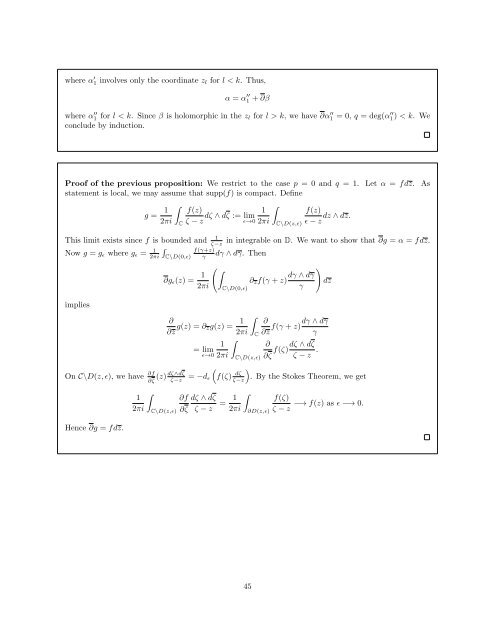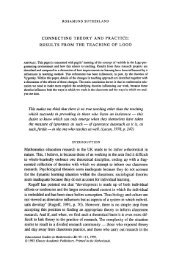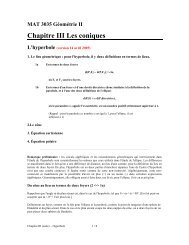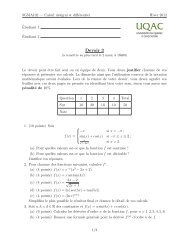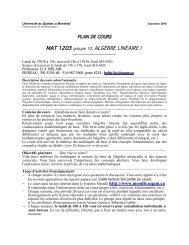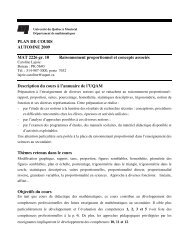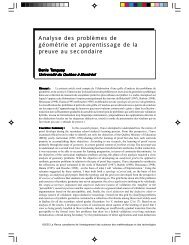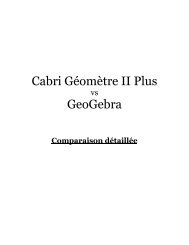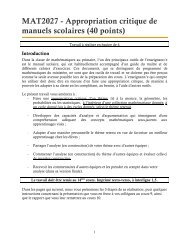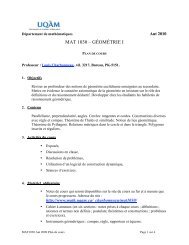COMPLEX GEOMETRY Course notes
COMPLEX GEOMETRY Course notes
COMPLEX GEOMETRY Course notes
Create successful ePaper yourself
Turn your PDF publications into a flip-book with our unique Google optimized e-Paper software.
where α ′ 1 involves only the coordinate z l for l < k. Thus,<br />
α = α ′′<br />
1 + ∂β<br />
where α ′′<br />
1 for l < k. Since β is holomorphic in the z l for l > k, we have ∂α ′′<br />
1 = 0, q = deg(α ′′<br />
1) < k. We<br />
conclude by induction.<br />
Proof of the previous proposition: We restrict to the case p = 0 and q = 1. Let α = fdz. As<br />
statement is local, we may assume that supp(f) is compact. Define<br />
g = 1 ∫<br />
2πi C<br />
f(z)<br />
dζ ∧ dζ := lim<br />
ζ − z ɛ→0<br />
∫<br />
1<br />
2πi C\D(z,ɛ)<br />
f(z)<br />
dz ∧ dz.<br />
ɛ − z<br />
This limit exists since f is bounded and 1<br />
ζ−z<br />
in integrable on D. We want to show that ∂g = α = fdz.<br />
∫<br />
Now g = g ɛ where g ɛ = 1<br />
f(γ+z)<br />
2πi C\D(0,ɛ) γ<br />
dγ ∧ dγ. Then<br />
( ∫ )<br />
∂g ɛ (z) = 1<br />
dγ ∧ dγ<br />
∂ z f(γ + z) dz<br />
2πi C\D(0,ɛ)<br />
γ<br />
implies<br />
∂<br />
∂z g(z) = ∂ zg(z) = 1<br />
2πi<br />
∫<br />
1<br />
= lim<br />
ɛ→0 2πi<br />
∫<br />
C<br />
C\D(z,ɛ)<br />
∂<br />
∧ dγ<br />
f(γ + z)dγ<br />
∂z γ<br />
∂<br />
∂ζ<br />
f(ζ)dζ<br />
∧ dζ<br />
ζ − z .<br />
( )<br />
On C\D(z, ɛ), we have ∂f dζ∧dζ<br />
(z)<br />
∂ζ ζ−z<br />
= −d ɛ f(ζ) dζ<br />
ζ−z<br />
. By the Stokes Theorem, we get<br />
Hence ∂g = fdz.<br />
∫<br />
1 ∂f dζ ∧ dζ<br />
2πi C\D(z,ɛ) ∂ζ ζ − z = 1 ∫<br />
f(ζ)<br />
−→ f(z) as ɛ −→ 0.<br />
2πi ∂D(z,ɛ) ζ − z<br />
45


